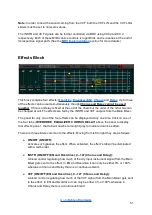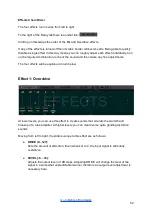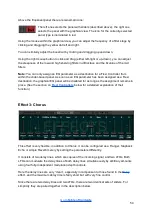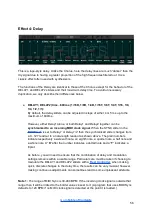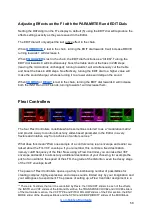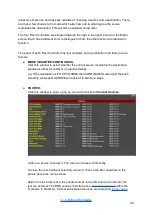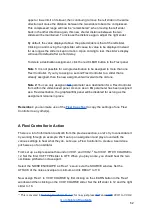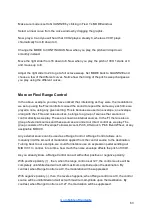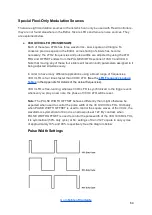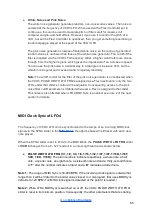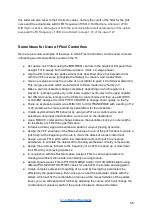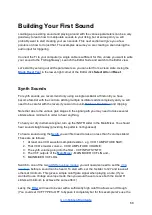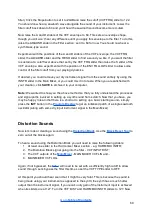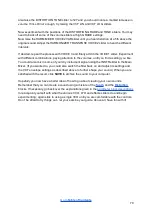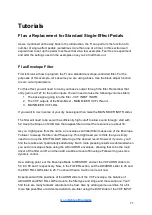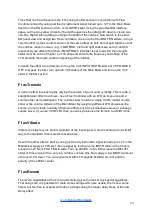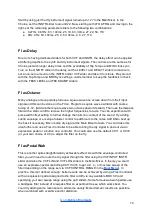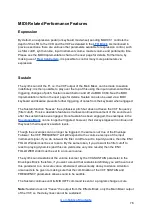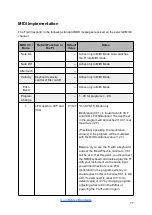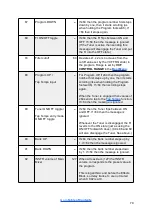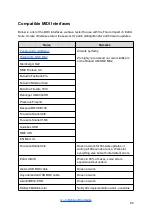
●
White Noise and Pink Noise:
The white noise generator generates random, non-consecutive values. The noise is
sampled at the frequency of VCO3 LFO. When used with a Flexi Controller set to
continuous
, this can be used to modulate pitch or filter cutoff for classic sci-fi
computer
sample-and-hold
effects. However, if you use it to control the pitch of a
VCO, but set the Flexi Controller to
quantized
, then you get something resembling a
random arpeggio played at the speed of the VCO3 LFO.
The pink noise generator is lowpass-filtered white noise, so the range of generated
random values is narrower than those of the white noise generator. The cutoff of the
filter is adjusted via the VCO4 LFO frequency slider. A higher cutoff lets more values
through from the higher regions, which gives the impression of an increase in speed.
You can use the pink noise in a similar way to a triangle or sine-wave LFO, but the
vibration is irregular and moves around completely randomly.
Note:
The cutoff control for the filter of the pink noise generator is
not
adjusted when
the VCO4 PULSE WIDTH LFO FRQ is assigned as a Flexi destination; only the two
LFOs under that slider’s control will be adjusted. Consequently, access to the pink
noise filter cutoff parameter is inhibited whenever a Flexi is assigned to that slider.
Pink noise is also affected when LFO4 MIDI Sync is enabled; see note 2 of the next
section for details.
MIDI Clock Sync of LFO4
The frequency of VCO4 LFO can be synchronized to the tempo of an incoming MIDI clock
signal via the SYNC slider in the
, though its phase will still reset with each new
note played.
When the SYNC slider is set to
LFO4
in the MIDI Block, the
PULSE WIDTH LFO FRQ
slider
of
VCO4
changes from a 0...127 readout to a note-length readout as shown below:
●
PULSE WIDTH LFO FRQ (1/1, 1/2, 1/4, 1/8, 1/16, 1/32, 1/4T, 1/8T, 1/16D, 1/16T,
1/4D, 1/8D, 1/16D):
The plain numbers indicate respectively a whole note, a half
note, a quarter note, an eighth note, a sixteenth note and and a thirty-secondth note.
A “
T
” after the number indicates a triplet and a “
D
” indicates a dotted note.
Note 1:
The range of MIDI Sync is 30-480 BPM. If the incoming clock signal is outside that
range then it will be limited to the border value closest to it. (A program that uses MIDI Sync
defaults to 120 BPM if no MIDI clock signal is detected at the point it is loaded.)
Note 2:
When LFO4 MIDI Sync is switched on or off, the VCO4 PULSE WIDTH LFO FRQ
slider is reset to its minimum position. Consequently, the other parameters that are sharing
65
Содержание Future Impact v3
Страница 8: ...Top Panel Controls and Display Connections Go to Table of Contents 8...
Страница 84: ...Appendix Go to Table of Contents 84...
Страница 85: ...Algorithm Block Diagrams Go to Table of Contents 85...
Страница 86: ...Go to Table of Contents 86...
Страница 87: ...Go to Table of Contents 87...

